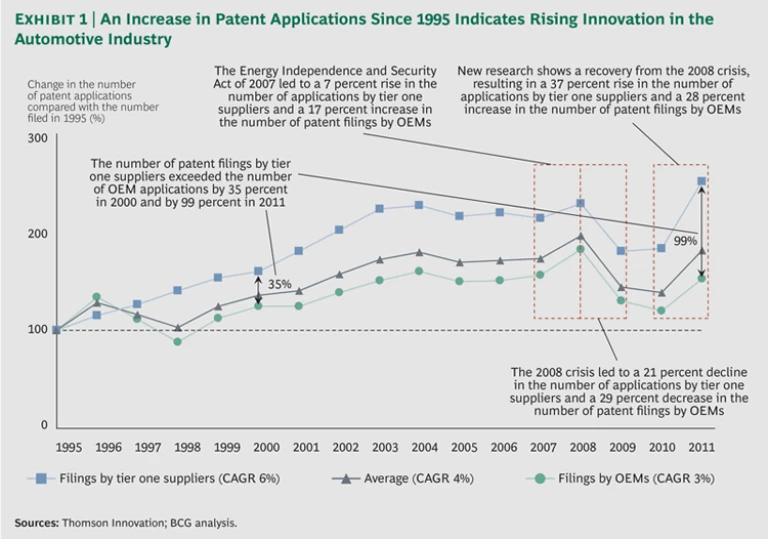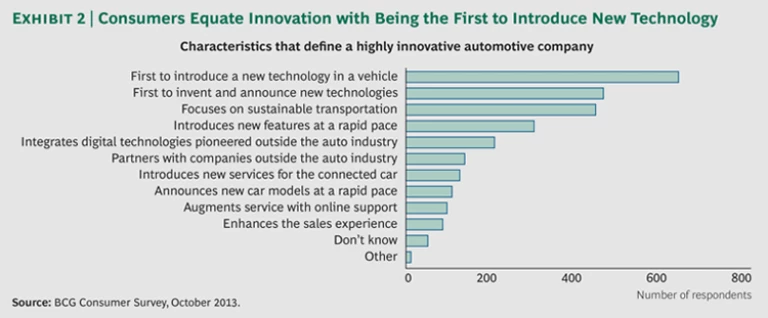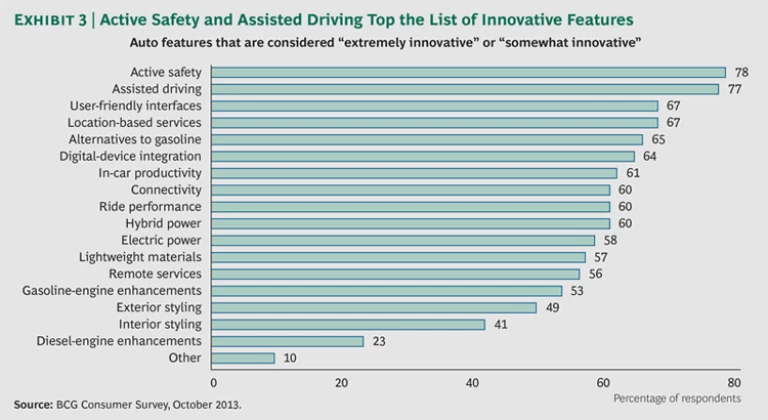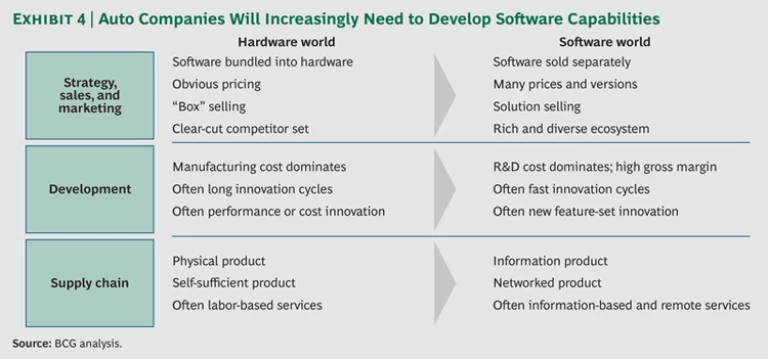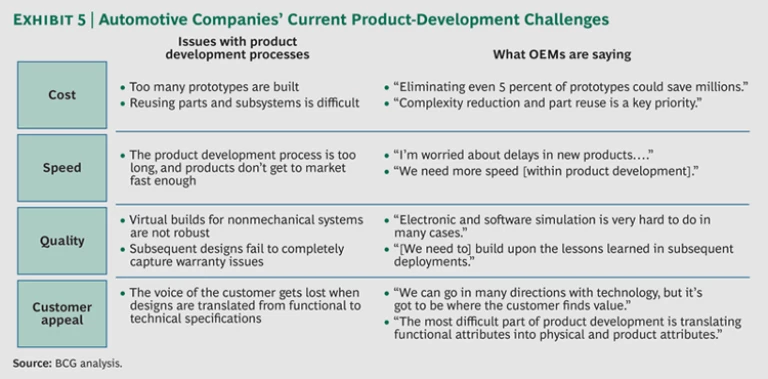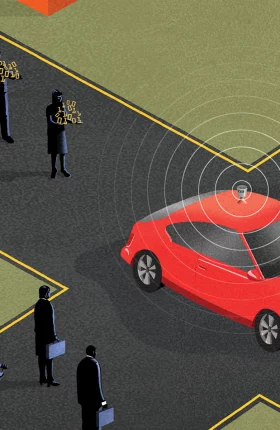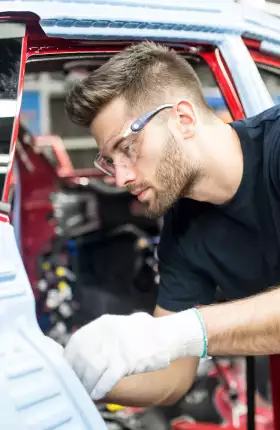Are we entering a new era of automotive innovation? Ever since the late nineteenth century and early twentieth century, when steam, electric, and gasoline (or petrol) engines competed for predominance, the automotive industry has been a major source of innovation. The earliest technologies came from Europe and the United States; Asia rose to prominence in the 1960s and 1970s. Today, automotive companies from around the world are competing on a global scale to bring new brands, models, features, technologies, and processes to market first. Innovation hit the brakes briefly in the wake of the 2008 global financial crisis, but our research and experience show that the pace of innovation accelerated again through 2013, and it is continuing as we enter the new year. Indeed, the recent and prospective developments in four key areas—power train, lightweight materials, connectivity, and active safety and assisted driving—may well herald a new golden age of technological advancement and automotive innovation.
Driving these improvements is an intensified focus among automakers and their leading suppliers on introducing new technologies faster, continuing to improve fuel economy and reduce emissions, and developing important connectivity and active-safety features (including assisted driving). Enabling these efforts is the transformation of the car from a collection of mechanical and hydraulic systems to a machine predominantly controlled by electronics and software. Together, these changes are altering the way cars are conceived, designed, manufactured, serviced, and driven. Companies that are today’s innovation leaders will need to keep on top of their game to stay ahead; those that lag risk falling further behind.
New research from The Boston Consulting Group shows that consumers cite innovation—both generally and in key areas such as connectivity, safety, and fuel economy—as an important consideration in their purchase decision. In this report, we examine the state of innovation among automotive original-equipment manufacturers (OEMs) and their leading tier-one suppliers. Our analysis indicates the following:
- Consumers want to buy cars from companies that bring new technologies to market.
- Connectivity and safety are important to consumers; they want to see innovation in these areas as well as in improving fuel efficiency.
- Continued consumer and regulatory concerns about oil prices, oil dependency, and global warming will ensure that technologies related to fuel efficiency and emissions reduction remain at the top of OEMs’ research agendas.
- OEMs will need to expand their R&D capabilities in electronics and software—areas where there is currently a scarcity of talent in the industry and where OEMs will have to compete with start-ups and technology companies.
- Tier one suppliers are becoming increasingly important in bringing innovations to market. This is a potentially tricky issue for OEMs, as these suppliers will develop and own intellectual property that represents important points of marketplace differentiation.
These factors will rapidly accelerate the pace of automotive innovation. They also will necessitate changes in the cost, speed, and quality of automakers’ new product-development programs, as well as in OEMs’ ability to adapt to evolving consumer demands.
A Renewed Focus on Innovation
Innovation has always been important in the automotive sector, but recent years have seen a renewed focus on new technologies and product features—a development that has not gone unnoticed. Automakers have increasingly vied with technology companies for top ranking in BCG’s annual survey of the most innovative companies. Fourteen automakers are among the top 50 in our most recent survey, compared with ten carmakers in 2012 and only five in 2005. (See The Most Innovative Companies 2013, BCG report, September 2013.) Three companies (Toyota, Ford, and BMW) rank in the top ten along with consumer electronics and Internet giants. Nine automakers are in the top 20. For the first time since BCG began conducting this survey, there are more auto manufacturers than consumer companies in the top 50 and more carmakers than technology companies in the top 20.
According to our survey, more automotive and technology companies perceive innovation and R&D investment to be important to the success of their businesses than do companies in other industries. Almost 85 percent of respondents in both sectors rate innovation as a top priority. About 70 percent of respondents from auto and technology industries plan to increase investment in innovation in the coming year.
Indeed, R&D spending by OEMs has accelerated, increasing at a rate of 3 percent a year from 2001 through 2012 and at an annual rate of 8 percent since 2009. At tier one suppliers, R&D spending has risen by 4 percent a year since 2001 and by 5 percent a year since 2009. Another measure of innovation, the number of patent filings, also reflects an increase. The patent activity of tier one suppliers has outpaced that of OEMs for the past decade and a half, with the number of filings increasing by 6 percent a year from 1995 through 2011, compared with a rise of 3 percent a year for OEMs.
Automakers rank high in the recently released 2013 EU Industrial R&D Investment Scoreboard.
Regulatory compliance is a major factor behind the current wave of automotive innovation. Manufacturers are racing to meet higher fuel-efficiency standards, which are rooted in concerns over oil dependency and the environment, especially global warming. Current standards mandate an average fuel economy of 54.5 miles per gallon (mpg) in the United States for the 2025 model year; the European Union is targeting 64.8 mpg by 2020; and China’s goal is 50.1 mpg by 2020. Automakers have stepped up the development of electric and hybrid vehicles and increased their efforts to improve the mileage of mass-market models through advancements such as more efficient power trains and lighter car bodies. Some 50 automotive models offer hybrid engines today, up from only 2 in 2001. Almost 15 percent of vehicles sold in Japan in 2013 had hybrid engines.
In addition to investing in electricity as an alternative energy source, automakers are committing capital to natural gas, hydrogen, next-generation biofuels, and fuel cell technologies. (See Powering Autos to 2020: The Era of the Electric Car?, BCG report, July 2011.) After a century of powering vehicles with gasoline and diesel, there is again a diversity of potential fuel sources, as well as uncertainty over which ones will take hold.
Another key factor driving innovation is the increasing number of software-driven electronic components in vehicles today. Fifteen OEMs currently offer telematics (location-based information and services, such as navigation assistance and vehicle-tracking programs), compared with four in 2001. These components enable quicker, less expensive innovations not only in telematics and on-board infotainment but also in features related to vehicle handling, safety, service, reliability, and performance. A typical premium-class car has as many as 100 microprocessors and operates on more than 100 million lines of software code—more than it takes to fly a fighter jet. Our research shows that the cost of electronic parts as a percentage of the total vehicle cost is expected to rise to 40 percent in 2015, compared with 20 percent in 2004. The increased prevalence of electronics will enable manufacturers to find new ways to both generate revenue and lower the costs of service and recalls (as long as OEMs can develop high-quality software for their vehicles). For tier one suppliers, the increasing number of electronic components in cars is a significant growth opportunity, as it drives a continuing shift of OEM spending from commodity mechanical components to higher-value-added electronics and software.
The pervasive popularity of mobile devices has led consumers to expect cars to contain advanced electronic and entertainment systems that integrate seamlessly with personal digital devices. Fortunately for manufacturers, the cost of electronic components has been dropping, so even low-cost vehicles today can contain a host of technologies previously found primarily in luxury models. For example, voice recognition software and Bluetooth connectivity are now available in lower-end mass-market models. Inexpensive no longer means lacking in advanced features.
The increasing number of on-board infotainment options is an area of heightened focus for regulatory agencies because of the potential for driver distraction. A technology arms race is under way between the infotainment options that can distract drivers and the active-safety features that maintain a safe driving environment. Someday, not too far in the future, autonomous cars will shuttle us to our destinations while we engage in work or play in our vehicles; less advanced versions of the “driverless” car already exist today.
Key Areas of Innovation
Three principal forces are driving innovation in the auto industry today: regulatory mandates with respect to fuel efficiency, emissions, and safety; consumer demand and expectations; and technological advances that enable the development of new features and reduce their cost. The result is that companies are concentrating their product-development efforts in four areas: power train, lightweight materials, connectivity, and active safety and assisted driving.
Our analysis of recent patent activity, using BCG’s proprietary intellectual-property assessment methodology, supports this view. Although patent filings are an imperfect indicator given that individual companies follow different approaches to protecting their IP, a look at the growth in and nature of patent filings over a period of years does provide a useful gauge of where innovation is taking place. Patent filings by the top OEMs on BCG’s list of the most innovative companies, as well as by the biggest tier-one suppliers, show double-digit growth from 1995 through 2011 in power train, lightweight materials, and connectivity, compared with an average growth rate for all patent filings by these companies of only 4 percent. The number of patent applications in the area of active safety grew by 6 percent annually. Moreover, the number of filings in all four areas showed only an 8 percent decline from 2008 through 2009, compared with an average drop in the number of applications of 26 percent. The number of filings in the four areas increased 10 percent faster than the average growth rate in the bounce-back years from 2010 through 2011.
Power Train
Aggressive fuel-economy and emissions regulations have focused carmakers’ efforts on two principal areas: increasing the efficiency of internal-combustion engines (ICEs) and developing hybrid gasoline-electric power trains. Thanks to improvements in turbocharging and direct-injection technologies, manufacturers have been able to shrink the size (and weight) of ICEs without an adverse impact on power. In fact, these improvements may lead to a shift in emphasis from diesel-powered to gasoline-powered engines among European automakers in coming years.
In the marketplace, hybrids are proliferating as options, and their penetration is increasing. Battery weight and cost, along with energy density (which directly translates to driving range), charging speed, and safety, have thus far constrained consumers’ acceptance of fully electric vehicles, as we discussed in our 2010 report on car batteries. (See Batteries for Electric Cars: Challenges, Opportunities, and the Outlook to 2020, BCG Focus, January 2010.) A big shift in regulatory requirements, such as the 2030 zero-emission target in California, would be necessary to boost further market development.
We expect more competition among engine technologies and fuel sources in the future, although the market will continue to be dominated by internal-combustion and hybrid engines in the near to medium term. The biggest impediment to adoption for some alternative fuels has little to do with technology. The main barrier is the catch-22 that exists between standardization and differentiation. Industry standards undermine manufacturers’ pursuit of differentiation as a marketing strategy. Yet absent industry-wide infrastructure standards (and big government incentives for investment), the infrastructure needed for alternative fuels to become mainstream is unlikely to be developed.
Lightweight Materials
The quest for greater fuel efficiency is driving more widespread use of lightweight materials, such as aluminum, magnesium, and carbon fiber. More small engines today are constructed from aluminum than from iron. The BMW i3 electric car, introduced in 2013, is constructed substantially of carbon fiber, which is one-quarter the weight of steel and five times stronger. However, carbon fiber components are up to ten times more expensive to manufacture and assemble. OEMs are therefore investing in component-manufacturing and assembly technologies that lower the cost of using carbon fiber and other lightweight materials. Just as aircraft manufacturers have moved to using composite materials to lighten the weight of newer model planes, so, too, are BMW, Volkswagen, Mercedes-Benz, and other major automakers increasingly manufacturing mass-market cars made of lightweight materials that traditionally were reserved for so-called super cars.
Connectivity
The car and consumer electronics are converging—with far-reaching ramifications. This phenomenon, which started in the 1990s with telematics (pushed into the mainstream by pioneers such as General Motors) and increasingly sophisticated on-board infotainment features, is now quickly morphing into an entire ecosystem of digital technology with the vehicle as the hub. Improvements in the capabilities and cost of cameras, sensors, software, and communications are enabling real-time connections from car to car, car to infrastructure, car to the cloud, and car to personal devices. Adding cellular connectivity and a Wi-Fi hub to a vehicle today costs less than $50 in incremental components per vehicle. Software controls a growing number of automotive functions and features, enabling cars to communicate with manufacturers, dealers, government authorities (for example, motor vehicle departments and toll collectors), and a host of other organizations and things, such as parking structures. If and when fully autonomous driving becomes a reality, the car could increasingly become a fully connected extension of the home and office.
Active Safety and Assisted Driving
The driverless car is no longer science fiction. Google has built it, and The Economist put it on its cover.
The electrification of the automobile has made it possible for previously isolated functions—steering and braking, for example—to communicate with each other. The driver is no longer a necessary link, processing feedback from one function and addressing the other accordingly. Software can perform the same job, often much more quickly and with a lower propensity for error. Software plus advances in camera, radar, and thermal technologies, as well as reductions in their costs, have given cars the ability to adjust and react to other vehicles (as well as to people, animals, and moving and immovable objects) on the road.
As the car becomes more aware of its surroundings, the potential for human error is reduced—and driver time is freed up. Imagine being stuck in traffic and engaging an “automatic cruise control” feature that lets you read the morning paper (on your tablet, of course), catch up on your e-mail, or work on that report due at the end of the day.
These technologies exist. The constraints to implementation lie elsewhere. It will take partnerships between governments, regulatory agencies, and manufacturers to navigate the legal and liability minefields between the laboratory and the highway. We do expect some to try—if for no other reason than consumer demand is real and growing, as our new survey shows.
Consumers Like What They See
Consumers value innovation in automobiles and recognize the companies that are leading the charge. New BCG research on U.S. consumers shows that most car buyers want to purchase a vehicle from a company seen as innovative. Almost 60 percent say this is a very or somewhat important consideration when choosing a new car. A key characteristic of an innovative automaker, according to car buyers, is being the first to introduce new technology.
U.S. consumers see features related to connectivity, safety, and fuel economy as the most innovative in today’s vehicles. More than two-thirds of respondents consider user-friendly interfaces, location-based services, and alternatives to gasoline to be innovative. Almost all respondents consider active-safety and assisted-driving features to be innovative. (See Exhibit 3.) It’s no surprise, then, that when U.S. consumers consider purchasing a new car, most rank connectivity and safety features in the top 5 of some 20 new features in vehicles today. Equally unsurprising is that consumers under 30 years old are most likely to value digital-device integration;active-safety features appeal most to consumers age 60 and older. Automakers should expect a growing demand for connectivity among members of the Millennial generation and for safety among aging baby boomers.
Consumers would like to see continued innovation in the areas of connectivity, safety, and fuel economy during the next five years. More than 50 percent of respondents think active safety should be a top priority, and 45 percent see technologies to improve fuel economy (including alternatives to gasoline, hybrid power, electric power, and gasoline-engine enhancements) as highly important.
The Implications for OEMs and Their Suppliers
Innovation in the automotive industry is retaking center stage. Concerns about oil prices, oil dependency, and global warming are causing regulators to continue pushing for fuel efficiency, alternative fuels, and reduced emissions. Consumers, meanwhile, want to purchase cars from companies that bring new technologies to market and do so quickly; connectivity, safety, and fuel efficiency are three of buyers’ top priorities. The ability to innovate in these areas will be a major factor in individual automakers’ success in the coming years. Yet OEMs will face challenges. The pace of innovation will increase, automakers will need to acquire more capabilities in electronics and software, and design and development processes will become more complex as they also come under greater time pressure. Automakers will be faced with unfamiliar sets of approaches and decisions related to the development and application of technologies.
Three areas that OEMs and tier one suppliers will need to address with a sense of urgency are the shift from predominantly mechanical to software-driven vehicles, the quickening pace of product development, and the increasingly prominent role of tier one suppliers in innovation and technological development.
The Shift from Mechanical to Software-Driven Vehicles
Cars are no longer primarily mechanical devices. Rather, automobiles are increasingly becoming software driven—literally, in the case of Google’s car. Given the rise of electronics and the fact that software features reduce tooling costs as well as allow for configuration later in the product development cycle, the shift to more software in cars will continue.
This shift requires auto executives to think about product life cycles—and the involvement of their companies with products during that time—in new terms. For example, some automobile components, such as entertainment systems and assisted-driving equipment, can be modified or replaced throughout the ownership cycle, giving automakers the opportunity to market new features long after the original vehicle sale—which can be a window of seven years or more. Other components can be refreshed and reconfigured without returning the vehicle to the dealer. Tesla Motors recently adjusted the highway-speed ground clearance of its Model S using an over-the-air software patch. As this kind of fix becomes the norm, consumers will increasingly look askance at companies that cannot meet an accelerated schedule of updates and improvements.
Designing components and software that can be regularly updated and impervious to “crashing” (in the computer sense of the word) is a new kind of management and product development challenge for the automotive industry. Manufacturers are only beginning to understand the magnitude of this tectonic shift as they pay—both financially and sometimes in terms of reputation—for fixing software bugs in the field; some 60 percent of warranty claims today are software related. As automakers undertake this challenge, they can learn from the experiences of companies in other industries. Aerospace and telecommunications, for example, have long histories of developing real-time embedded software that has a high degree of reliability. Companies in these industries are good sources of time-tested practices and capabilities.
Big changes in the approach to product design and development could be on the horizon. A potential shift is decoupling the hardware and software design processes and adopting a two-speed approach to product development. Chassis and power train development, for example, have different design requirements and cycles than do connectivity and software solutions. As connection speeds, bandwidth, computing power, and graphics capability join horsepower, torque, and miles per gallon as key technical criteria, does it continue to make sense to have them conform to the same design and development process?
In addition to considering a two-speed product-development process, OEMs will need to add software architecture capabilities and strategies. Automakers will need to determine which layers of the software stack they want to develop in-house and which layers can be programmed by tier one suppliers or others. Increasingly, automakers may find themselves in competition with technology companies for ideas and for talent. As connectivity and complexity in cars grow, vehicles will also become more vulnerable to hackers, necessitating a greater focus on security. These few examples highlight the growing convergence of more traditional IT and software-product development, which OEMs will need to manage.
The Quickening Pace of Product Development
Consumer electronics and technology companies have taught consumers to expect a rapid pace of innovation. This expectation will make it more and more difficult for automakers and their suppliers to maintain the current three- to five-year product design and development process. To put the issue in perspective, think of all the already outdated CD-ROM-based in-car navigation systems that are only a few years old. Today’s consumers get real-time information delivered on their smartphones.
OEMs understand that today’s multiyear product-development processes and long product life cycles contain many bottlenecks and pain points that add time and expense, mute customer input, and undermine quality. (See Exhibit 5.) These challenges for carmakers are complicated by the need to make the transition from predominantly mechanical engineering processes to digital ones that fully integrate hardware, electronics, and software and are akin to the processes of consumer electronics manufacturers. For automakers, the adoption of shorter product life cycles may not be unlike software companies moving from a gate-based, waterfall development methodology, with all its checkpoints and certifications, to faster approaches that borrow from agile systems, which revolve around collaboration among self-directed, cross-functional teams. Digital product-development capabilities may increasingly enable digital simulations that model full-vehicle functionality, reducing the need for the lengthy construction of physical prototypes.
We expect to see increased experimentation with, and adoption of, alternative design processes, new development models, and, in the longer term, advanced manufacturing techniques. Several manufacturers are already experimenting with community collaboration models in the product design and development stages, tapping into external and internal open-source and crowd-sourced solutions to solve design challenges. Local Motors, a new-generation design company that counts BMW, Peterbilt, and the U.S. Defense Advanced Research Project Agency among its partners, lets automakers pose problems to a virtual community of more than 30,000 designers, fabricators, engineers, and enthusiasts from around the world. For the modest cost of approximately $11,000, OEMs can sponsor a design competition and access this pool of talent.
Gaining access to new reservoirs of talent and insight has the potential to accelerate and improve the design and development processes, but this approach can also lead to issues of IP ownership, liability, and the flight of internal talent. OEMs may not need to access outside communities for help, as there is often a wealth of know-ledge among in-house engineers. Carmakers can create their own communities to tap the company’s engineering expertise and solve problems. OEMs should explore new collaborative techniques to drive innovation—and to attract critical young engineering and design talent familiar with rapid, iterative, and open approaches.
Across the product development value chain—from conceptualization through design, development, and production—we expect new technologies and approaches to have a growing impact. OEMs have been investing R&D dollars in more integrated product-development IT systems that will enable global engineering collaboration, virtual simulation of engineering designs, and greater reuse and sharing of components and designs. Computer-aided design and product-life-cycle management are mature technologies, but by some estimates, only 10 percent of the capabilities built into these systems are currently used. By adopting design and simulation tools, or by making better use of current ones, automakers will find that they can significantly improve product development processes and speed, reduce errors, and facilitate change management. Borrowing techniques such as agile development from the software world and applying them to mechanical and electrical design can also help reduce development times and cost.
With access to cheap computing power and the increased accuracy of simulation software, OEMs need to explore how to develop and test products through simulations instead of costly real-world prototypes and testing. Where physical prototypes are necessary, digital tools still have the ability to vastly lower costs and accelerate cycle times by replacing expensive real-world tests and experiments with simulations. Automakers will be able to take advantage of innovations in additive manufacturing and other computer-aided-manufacturing methods to reduce the time it takes to create and test prototypes. Some start-ups, such as the team behind the Urbee cars, are experimenting with 3-D-printed body panels to more quickly evolve design concepts. In addition to the ability to print single-material parts, 3-D printing offers promise for materials science innovation by enabling multimaterial-printed parts with unique properties, or the tighter integration of mechanical and electrical components.
Although 3-D printing has received much attention, the pace of innovation is also increasing in other areas, such as the fabrication of composite materials, advanced robotics, and other direct-from-digital-to-physical fabrication methods. Advanced manufacturing processes are rapidly evolving, and we predict they will be a future source of automotive innovation, enabling companies to find new approaches to incorporating into car designs lightweight, composite materials that advance fuel efficiency and performance. OEMs will need to consider allocating some of their R&D spending on advanced technologies to explore manufacturing innovations.
Innovation is hard to measure. Perhaps one of the biggest challenges for OEMs as they rethink the product development process is matching new technologies with what customers want. Those companies that can optimize their product-development resources to most consistently deliver new vehicles with the features and capabilities that customers value most will find themselves pulling ahead of the competition.
The Increasingly Prominent Role of Tier One Suppliers
Traditionally, OEMs have focused their R&D efforts on power train, interior design, and chassis components, because these have been the principal differentiators for car manufacturers. As tier one suppliers play a bigger role in innovation in these areas—and as the determinants of differentiation shift toward connectivity and active-safety features, in which tier one suppliers have substantial expertise—the importance of these companies in product development escalates. OEMs will increasingly rely on tier one suppliers for product differentiation, and those manufacturers that construct the most effective collaboration models, encouraging and rewarding supplier R&D investment, will build a long-term advantage.
Articulating clear medium- and long-term product and technology roadmaps will become more important as OEMs determine which areas of innovation will remain the focus of in-house R&D and which will be led by tier one suppliers. OEMs will also need to think about co-development and joint-venture models to capture innovation from external sources. New collaboration models with existing suppliers will need to be managed, as will new arrangements with large companies outside the auto industry, start-ups, and engineering and design communities.
All of this raises issues of IP ownership and control, which will likely require auto manufacturers to develop new IP and risk-management models to govern nontraditional but increasingly important relationships. The question of who controls important and visible points of technological differentiation could become increasingly intricate points of negotiation among OEMs, their tier-one suppliers, and new partners from other industries.
In addition, OEMs will have to consider partnering with other OEMs not only to set industry standards but also to fund the development of new IP that requires significant investment. Partnerships with “open” vendors—those working in the same innovation area with more than one OEM—and with new entrants to the industry will also become more prevalent, in light of demands for faster innovation and the need to scale up new technologies quickly. OEMs will face a growing number of decisions over whether to push the development of certain technologies alone or with a partner (and which one). These determinations will require the right decision-making framework to balance emphasizing speed, reducing scale-sensitive costs, and establishing product differentiation.
A New Golden Age
Topping the list of challenges facing the automotive industry are the shift from predominantly mechanical to software-driven vehicles, the quickening pace of product development, and the increasingly prominent role of tier one suppliers in innovation and technological development. Automakers that meet these and other challenges will position themselves to take advantage of opportunities and develop new revenue streams. For example, by 2015, we expect about 60 percent of new cars to be connected—to the cloud, to users’ devices, to other cars, or to infrastructure. This “connected platform” will demand new services and business models. Just as an ecosystem of developers emerged to build applications for smartphones and tablets, OEMs could find themselves maintaining their own version of an app store and managing an ecosystem of partners. One OEM’s ecosystem may provide a new basis for competition with another, much as Apple’s iOS and Google’s Android operating systems slug it out today, each with its own unique approach that is built around its own distinct competitive attributes.
The increased importance of software—embedded, real-time vehicle-management systems as well as hosted applications that provide new services to customers—will require different approaches to pricing, channel management, billing, and customer support that are common in the software industry but fundamentally new to automotive companies. OEMs will have to develop new capabilities, systems, processes, and ways of thinking about their products and customers.
Other areas of innovation, such as assisted driving and infrastructure for alternative fuels, loom large as well. Unlocking the value of these will also mandate new kinds of thinking and collaboration—such as a considerably higher degree of cooperation among OEMs and between OEMs and government regulators than has historically been the norm. Harnessing the power of a broad software-developer base will require standardization in application programmer interfaces. The product liability issues that will keep driverless cars on the test track and off the road can only be addressed through a joint approach involving the auto and insurance industries and government.
A new golden age of automotive innovation is indeed upon us, with exciting prospects for both consumers and young, talented engineers across multiple disciplines. Whether it heralds an order of change that matches the impact of the combustion engine or Henry Ford’s assembly line remains to be seen, but we can be sure that it will not lag far behind. The automakers that determine how to organize themselves to harness and direct fast-moving developments in power train, lightweight materials, and, most critically, electronic components, software, and connectivity will establish an advantage over competitors in the near and longer term.
Acknowledgments
The authors are grateful to the following BCG partners and colleagues for their insights and assistance: Michelle Andersen, Andreas Dinger, Euene Foo, Marco Gerrits, Andreas Klotz, Lara Koslow, Tobias Krause, Kate Manfred, David Martin, Gretchen May, David Ritter, Michael Rüßmann, Andrew Taylor, and Nicole Voigt.
